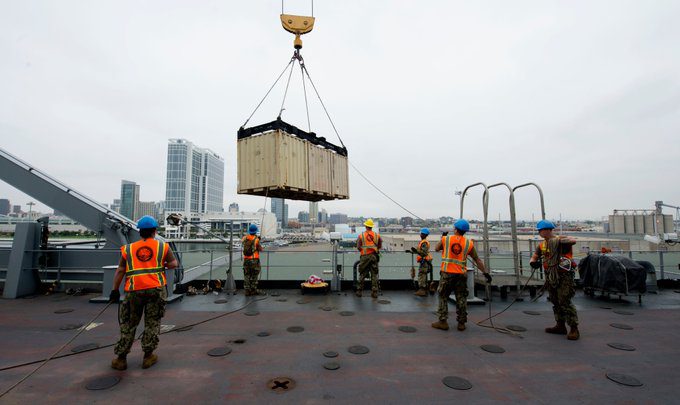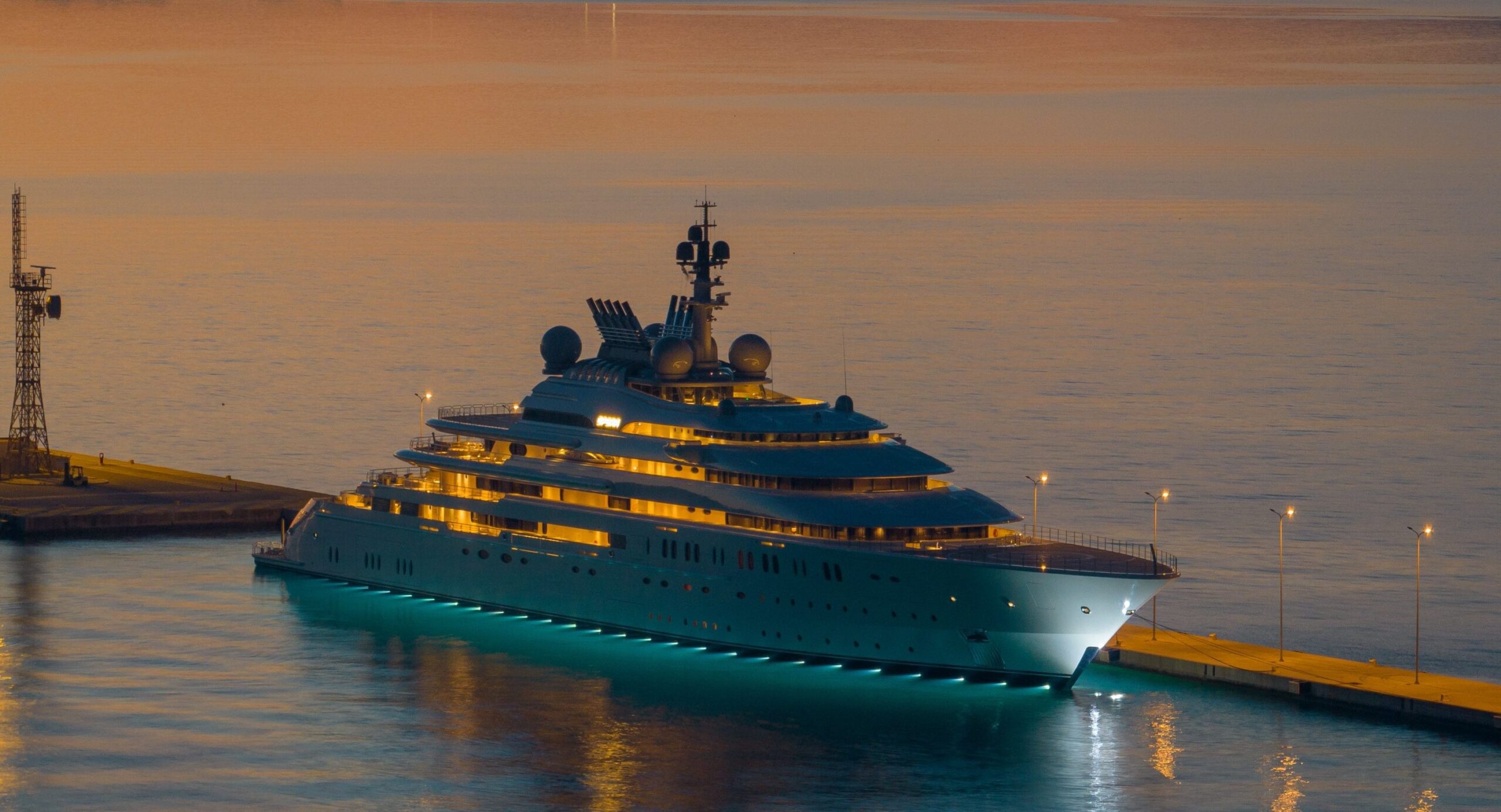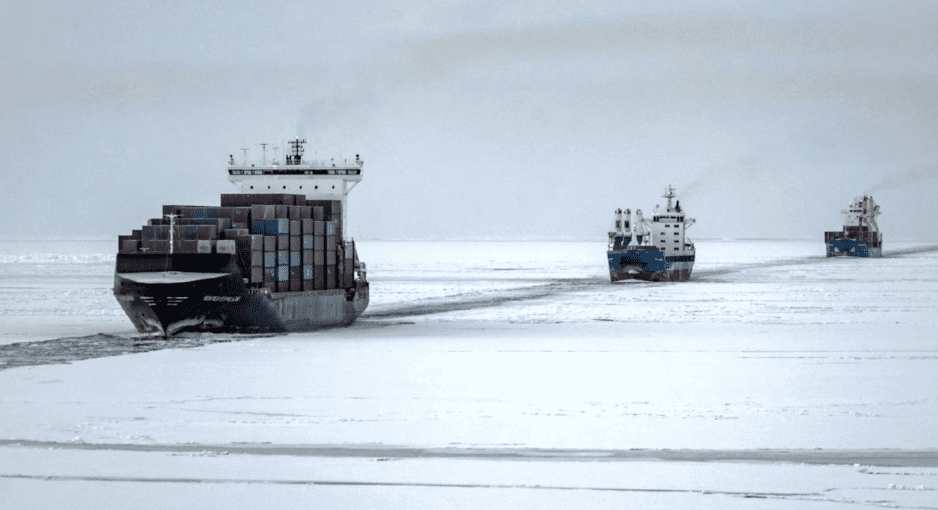U.S. Transportation Command Photo
By Sal Mercogliano, Ph.D. – In a week punctuated by a drone missile strike on two oil production plants in Abqaiq, Saudi Arabia, the United States Transportation Command on Monday initiated a Large-Scale Sealift Readiness Exercise. As part of its Turbo Activation series which began in 1994, the joint command, located at Scott Air Force Base in southern Illinois, issued activation orders for 22 ships from the Maritime Administration’s Ready Reserve Force and 6 vessels from the Military Sealift Command. This activation of 28 ships at one-time is the largest single-day activation in the history of the surge sealift force. Even during the conflicts in 1990 and 2003, when a total of 86 and 58 ships were broken out of the reserve fleets respectively, this figure exceeds any single day. So why now, and what is the background for this exercise?
In 1965, when President Lyndon Johnson called up US forces to deploy to Vietnam, the cargo fleet held by the Military Sea Transportation Service (renamed Military Sealift Command in 1970) proved too small to accommodate the forces. The commercial merchant marine responded, even calling off a strike on the East Coast of the United States to meet the needs of the nation. However, they announced they would not be able to maintain the flow of supplies to Vietnam due to commitments on their established shipping lines. Sitting in anchorages scattered along the coast of the United States were remnants of the massive World War Two building program undertaken by Admiral Emory S. Land and the United States Maritime Commission. Eventually, 172 ships were targeted for break out from the National Defense Reserve Fleet (NDRF), but high costs to activate, difficulties in restoring vessels after twenty years, and in some instances, fires and explosions in machinery spaces demonstrated the need for something better.
After the Vietnam War, the Maritime Administration recommended that 30 Victory ships, those in the best material condition be selected as the core of a new entity that could be activated quicker and more reliable than the NDRF. The new Ready Reserve Force (RRF) came into existence in 1977 with SS Catawba Victory being ship number one. The decline in the American merchant marine proved an unfortunate windfall for the RRF as more modern vessels were available and the fleet grew to 94 on the eve of the Persian Gulf War of 1990. They were joined by eight modified SeaLand SL-7 containerships, acquired by the Navy and converted into Fast Sealift Ships (FSS) for the Military Sealift Command.
On August 7, 1990, the eight FSS received their activation orders and sailed to their ports of embarkation in Savannah and Wilmington. They embarked elements of the 24th Infantry Division from Fort Stewart, Georgia and represented the first armor heavy units of the US Army earmarked to defend Saudi Arabia. The need for vessels and speed led to all eight being utilized even though USNS Antares was slated for a major overhaul. She subsequently broke down in the Atlantic and had to be towed to Cadiz, Spain by the fleet tug USNS Apache and her cargo transferred to the returning USNS Altair. Antares damage proved substantial and remained under repair in Gibraltar throughout the conflict.
Three days after the Fast Sealift Ships received their orders, the 17 roll-on/roll-off vessels in the RRF began their activation sequence. All the ships were designated to activate in five days, but two – Cape Lambert and Cape Diamond – fell well outside of the window, taking 60 and 131 days, respectively. It was a result of these difficulties that the US Transportation Command, along with the Maritime Administration, initiated the Turbo Activation exercises. Identifying the need for 20 million square feet of cargo space, the Department of Defense recommended the purchasing of additional roll-on/roll-off ships for the RRF, the conversion and construction of new large medium-speed ro/ros (LMSRs), an augmentation of the prepositioning fleet, and the creation of the Maritime Security Program.
In 2003, with war again looming against Iraq, forty vessels of the RRF were activated along with the eight Fast Sealift Ships and ten LMSRs. All the ships, except three undergoing routine repairs – Cape Ducato, Cape Lobos, and Cape Lambert – met their timelines. These ships required a total of 1,200 mariners to crew them during the conflict.
The activation ordered this week is meant to stress test the current 61 ship fleet held by MARAD (46 ships) and MSC (15 ships). In March 2019, in a testimony before the House Armed Services Committee, MARAD Administrator Mark Buzby and the Commander, US Transportation Command, General Steve Lyons, highlighted the precarious nature of the surge sealift fleet. Most damning was a chart that showed the condition of the ships. On average they are 44 years old, 13 of the 61 were not mission capable due to needed repairs, and 6 had lost their certificate of inspection from the US Coast Guard. This represented a 31 percent reduction in the total surge sealift capacity of the nation.
Beyond the age and poor material condition of the fleet, they also highlighted the crucial shortfall in the number of accredited mariners, particularly senior unlimited tonnage license holders, available to man the fleet in case of a peer-to-peer conflict lasting more six months. In the words of Mr. Kevin Tokarski, the associate administrator of MARAD for Strategic Sealift, “We’re on the ragged edge.”
The decline in the commercial merchant marine, due to the creation of the interstate highway and pipeline systems – which reduced the coastal traffic of the United States – the end of construction and operational differentials, the closing of Navy Yards and the shift of military contracts into commercial shipyards with the 600-Ship Navy, and the proliferation of open registries (more commonly referred to Flags of Conveniences) all led to the decline of the commercial unlimited tonnage fleet of the US merchant marine. The fleet fell from its position as number one after World War Two, to 22nd in the world today, with just 180 ships, over 1,000 gross tons, remaining.
With an aging fleet of surge sealift ships, shortages in available manpower, the commercial fleet – particularly the coastal Jones Act fleet – under attack from groups such as CATO and AEI, and a recent report that critique how MARAD and MSC maintain their reserve ships, this exercise is a bold demonstration of the nation’s ability to deploy its forces from the Continental United States overseas. While the nation boasts the strongest military in the world, the lack of an adequate reserve surge fleet and a declining commercial merchant marine indicates the difficulty of the United States to adequately project military power, in particular for the U.S. Army. In many ways, shortfalls, issues, and even failures in the activation of these 28 ships from the Ready Reserve Force and the Military Sealift Command should be a wake-up call to the government, the Department of Defense, and the public at large what a declining merchant marine means for the United States national security going forward.
Salvatore R. Mercogliano is an associate professor of History at Campbell University.

 Join The Club
Join The Club











